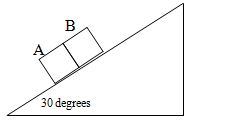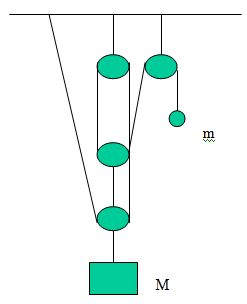Discuss the below:
1. Blocks of equal mass M sits on a plane inclined at 30 degrees to the horizontal. The coefficient of friction between the lower block (A) and the plane is 0.50 and between the upper block (B) is 0.30. (a) Find the acceleration of each block and the normal force exerted on A by B (b) What happens if the two blocks are reversed do that B leads the way down?

2. (a) Pulleys in the system are massless and frictionless, what mass m must the ball have if it is to support the cylinder of mass M? (b) if m=M, find the acceleration of each of the objects?

3. Assume a person jumps a planetary surface with roughly the same speed no matter on which planet the jump occurs. If Alan can jump 1 m high on earth, how high can he jump on the Mom? Neglecting any variation of gravity, how high can he jump on an asteroid with density=5500 kg/m (3rd power)? Is it okey to neglect the variation of g above the asteroid's surface?
How do I set this problem up?